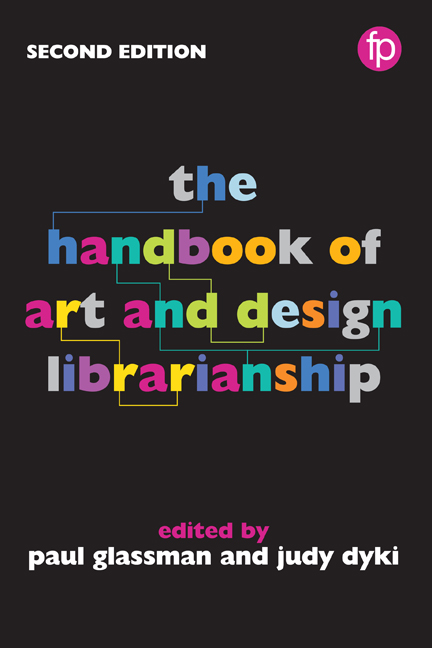Book contents
- Frontmatter
- Contents
- List of figures and tables
- Notes on contributors
- Foreword
- Preface
- Part I Roles and responsibilities
- Part II Materials and collection management
- Part III Teaching and learning
- Part IV Knowledge creation
- Part V The physical environment
- 25 New, renovated and repurposed library spaces: responding to new demands
- 26 Why is that column in the middle of the room? Success in creating classrooms for library instruction
- 27 Finding common ground: creating library spaces for collaboration
- Part VI Promotion and sustainability
- Appendix Library profiles
- Index
27 - Finding common ground: creating library spaces for collaboration
from Part V - The physical environment
Published online by Cambridge University Press: 08 June 2018
- Frontmatter
- Contents
- List of figures and tables
- Notes on contributors
- Foreword
- Preface
- Part I Roles and responsibilities
- Part II Materials and collection management
- Part III Teaching and learning
- Part IV Knowledge creation
- Part V The physical environment
- 25 New, renovated and repurposed library spaces: responding to new demands
- 26 Why is that column in the middle of the room? Success in creating classrooms for library instruction
- 27 Finding common ground: creating library spaces for collaboration
- Part VI Promotion and sustainability
- Appendix Library profiles
- Index
Summary
Introduction
Far from the image that libraries are staid and static places, the academic library of the 21st century is a site of continuous evolution in an attempt to stay current with the needs of its users. To be relevant, libraries must keep pace with users’ research, learning and technology needs. Users continue to come to the library to access its scholarly resources, but as these resources increasingly move online and print materials are shifted to other areas of the library or remote storage, the library's building no longer serves primarily as a space for housing materials. In addition, acquisitions budgets continue to shrink, and more resources are shared among libraries either through interlibrary loan or acquired through patron-driven acquisitions. The newer model of collections is point of need. Signalling this trend, the Association of College & Research Libraries (ACRL) lists one of its 2016 top ten trends in academic libraries as collections assessment to promote ‘rightsizing’ of collections.
There is an increasing need to establish more holistic and agile approaches (qualitative and quantitative) to manage budgetary constraints while ensuring that collections are ‘responsive’ and committed to institutional research and curricular requirements and needs (ACRL, 2016).
These combined changes and pressures on collections are also freeing up space in libraries. As shelves for under-used collections move out with their volumes and yield more space, libraries are embracing the opportunity to respond to their users’ desire for more space. Libraries are repurposing this space for studying, meeting and learning, often alongside these materials. This shift in library use and service is what Megan E. Macken refers to as the ‘learning-centered model of library space planning’ (2006, 23). Learning is central to the purpose of creating new, collaborative spaces for users, and this manifests in a variety of ways.
Creating spaces: individual, collaborative and social
The information commons is a well established space within most academic libraries. Generally a large and open space, the information commons can provide study space with tables and chairs, or adjacent carrels. For technology needs, it can have computers or outlets for connecting laptops to a power source. Alternately, it can serve as a social space. While this type of space is useful for students working on their own or with a partner, its openness limits it for other purposes.
- Type
- Chapter
- Information
- The Handbook of Art and Design Librarianship , pp. 287 - 294Publisher: FacetPrint publication year: 2017



